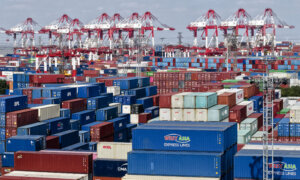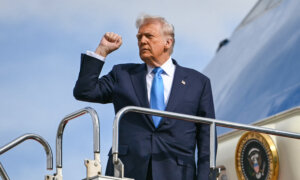The Chinese regime has stated that it will impose tariffs on U.S. energy imports and other products. China annually purchases about $8.5 billion worth of U.S. energy products, which it now plans to target.
On Feb. 4, Chinese regime authorities announced they would enact countermeasures against certain U.S. exports in retaliation for new tariffs enacted on Chinese imports the same day.
They said China would implement a 15 percent tariff on coal and liquefied natural gas (LNG) products and a 10 percent tariff on crude oil, agricultural machinery, and large-engine cars imported from the United States. The tariffs are expected to take effect on Feb. 10.
The move is in response to President Donald Trump’s order on Feb. 1 to impose a 10 percent tariff on all goods imported from China. That duty went into effect on Feb. 4.
In a statement released to the press, China’s State Council Tariff Commission said the U.S. tariffs “violate the rules of the World Trade Organization.” Chinese state-run media agency Xinhua announced that the country filed a formal complaint about the tariff with the World Trade Organization on Feb. 4.
Also, on Feb. 1, the United States said it would raise duties on Canadian and Mexican imports. However, on Feb. 3, the leaders of both nations said they had reached a deal with the United States to pause those actions.
On Feb. 3, White House press secretary Karoline Leavitt told reporters that Trump would speak with Chinese Communist Party leader Xi Jinping “in the next couple of days.”
On the afternoon of Feb. 4, when asked about the tariffs, Trump said, “It’s fine.”
“We’re going to do very well against China and against everybody else,” he said. “They’re using our money to build their military, and [former President Joe Biden] let that happen.”
According to the U.S. Energy Information Administration (EIA), China was the world’s top energy consumer as recently as 2021. However, the majority of its imported inputs come from countries other than the United States.
Coal
According to an analysis published by the EIA, last updated in November 2023, about 70 percent of Chinese energy production in 2021 was generated by coal-fired power plants. The country is also the world’s top producer of coal, but it still must import the fuel to meet its massive needs.
According to the EIA, in 2022, China produced about 4.8 billion tons of coal but used about 5 billion tons.
In that same year, Indonesia accounted for 89 percent of Chinese coal imports. The EIA analysis said historically, Australia is a major coal supplier to China, but trade was limited because of political issues in 2022. In 2023, Australia resumed shipping more than 5 million tons of coal per month to China.
By comparison, according to the EIA’s most recent figures, the United States shipped about 5 million tons of coal to China in 2023. Nevertheless, that figure nearly doubled to about 8.7 million tons in the first nine months of 2024.
By the end of September 2024, the United States exported about 79.9 million tons of coal. In that period, Chinese consumption accounted for about 10.9 percent of overall U.S. exports. India, not China, was the largest export destination for U.S. coal. India received more than 19.5 million tons of U.S. coal in the first nine months of 2024.
According to the EIA, the average U.S. coal export price was about $120 per ton in the third quarter of 2024. Assuming all coal was traded at about that price, the United States exported about $1 billion worth of coal to China in the first nine months of 2024.
LNG
As for LNG, the EIA analysis said Australia was the chief source of LNG for China in 2022. LNG accounted for 59 percent of the country’s overall natural gas imports in 2022, with the remaining 41 percent being piped in from Turkmenistan, Russia, Kazakhstan, Burma (also known as Myanmar), and Uzbekistan.
Overall, in 2022, China imported 3 trillion cubic feet of LNG, according to the EIA.
Reuters, citing an unidentified source, said on Feb. 4 that more than 5 percent of China’s LNG imports come from the United States.
In 2023, the U.S. exported 173.2 billion cubic feet of LNG to China, according to the EIA, at an average price of $8.42 per thousand cubic feet. At that price, China imported about $1.5 billion worth of LNG from the United States in 2023.
By comparison, the United States exported 4.3 trillion cubic feet of LNG in 2023, according to the EIA. The Netherlands and France were the largest importers of LNG that year, with 588.6 billion cubic feet and 492.9 billion cubic feet of LNG purchased from the United States, respectively. In 2023, China received about 4 percent of the LNG the United States exported.
According to the EIA, in 2023, LNG accounted for about 57 percent of the 7.6 trillion cubic feet of natural gas the United States exported worldwide.
Crude Oil
According to the EIA, in 2022, China imported most of its crude oil and condensate from Middle Eastern sources or Russia. Saudi Arabia and Russia, the largest individual sources of crude oil to China, both accounted for 18 percent of its crude oil imports.
The United States, by comparison, only accounted for 2 percent of China’s crude oil imports in 2022. Reuters, citing an unidentified source, said on Feb. 4 that the total dropped to 1.7 percent in 2024, or about $6 billion worth of oil.
In 2023, the United States exported 167.4 million barrels of crude oil to China. However, the Netherlands was the largest importer of U.S. oil. That year, according to the EIA, it imported about 227.7 million barrels of crude oil.
In 2023, according to the EIA, the U.S. exported about 1.5 billion barrels of oil. China accounted for about 11 percent of total U.S. exports.
Automotive
In a social media post, Lei Xing, a longtime observer of the Chinese automotive market, said the Chinese tariff will predominantly target passenger vehicles, pickup trucks, and trailers for agricultural use.
Xing, a consultant and co-host of the “China EVs & More” podcast, cited data from a Chinese automotive association showing that China imported about 110,000 vehicles from the United States.
Xing predicted that the tariff would affect the so-called Big Three automakers—Ford, General Motors, and Stellantis—but would not significantly affect their business.
“In the grand scheme of things, the well-being of American automakers and all foreign automakers, for that matter, in China will not hinge on the tariffs and imports,” Xing said on social media. “The 10 percent tariffs for now is more of a slap on the wrist.”
Reuters and The Associated Press contributed to this report.














